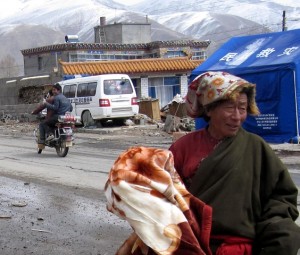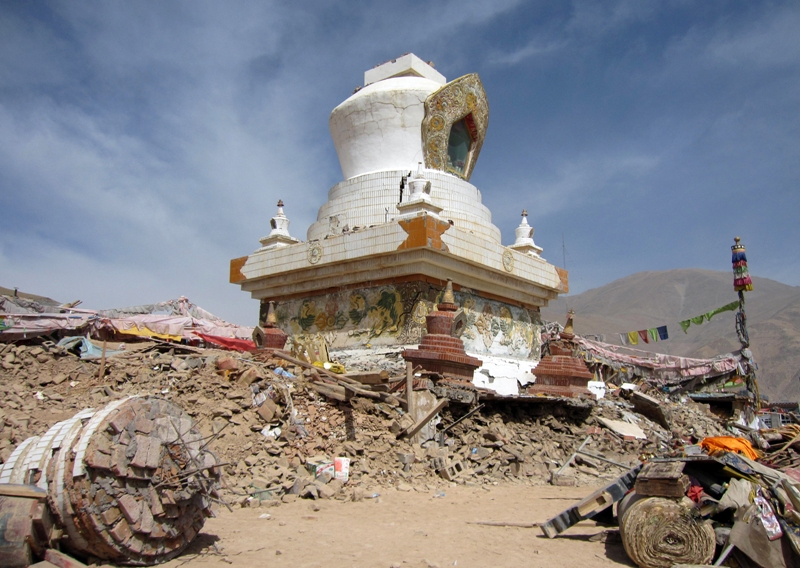Thursday
Mandala ProjectsOngoing Relief Efforts by the Surmang Team
Khenpo Tsering has continued to update the Konchok Foundation daily about the ongoing efforts by the Surmang team to support those affected by the earthquake. Aten Rinpoche, along with several monks, remains in Jyekundo. Trungpa XII Rinpoche and others of the monks are at Surmang, continuing with pujas. This report, shared by Lyndon Comstock of the Konchok Foundation, covers the period April 24-27.
By Lyndon Comstock
The situation in Jyekundo is rapidly evolving beyond the emergency relief needed in the immediate wake of the disastrous earthquake. A more long-term set of issues will soon emerge as to how the people of Jyekundo, and of the surrounding region, will cope during the rebuilding period, which will last for years.
The impact of the earthquake on the region could scarcely be overstated. In addition to the many thousands of people killed or injured, there are on the order of 125,000–150,000 people who lost their homes. Most of these people will be without a permanent home for some years as rebuilding takes place. That difficult challenge will be exacerbated by the cold climate.
Ten Days after the Quake
For the first ten days after the April 14 earthquake, the Surmang team worked as hard as they possibly could to provide emergency assistance to hundreds of families in Jyekundo. Aten Rinpoche and Khenpo Tsering have continued since then to meet with families, but on a less intensive basis then in the period right after the earthquake. In the last several days they have met with, and provided support to, several dozen families connected to Surmang whom they were unable to track down in the initial confusion after the earthquake.
The Surmang leadership does intend to continue providing ongoing assistance to those who were affected by the earthquake, particularly those families that they personally know. They are now considering how they can best do that as the situation evolves. We at the Konchok Foundation will also be consulting with our disaster relief adviser for advice as to how we can be supportive in the next phase.
Both Khenpo Tsering and team members at Konchok Foundation have commented in the past several days that the effects of the earthquake make opening the Surmang shedra more important than ever. We will have to more to say about that topic in the coming weeks.
Present Conditions
A very severe and unusual dust storm was taking place in Jyekundo when I spoke with Khenpo on the 25th. Other than a dust storm that also took place just before the earthquake, no one can recall a severe dust storm of this type. The dust storm shut down the airport. There has also been heavy snow between Xining and Jyekundo, interfering with truck traffic.
Nonetheless, the situation with relief supplies has eased compared to the initial period after the earthquake. Some commercial activity is starting to take place, outdoors or in tents. Some of the schools have re-opened in tents, although, tragically, at least two hundred schoolchildren, and probably more, were killed.
Reliable reports indicate that the entire population of Jyekundo will be evacuated from the city before the end of May. About 100,000 people lived in Jyekundo at the time of the earthquake. It is likely that the government will raze to the ground most of those buildings that are still standing in the city prior to the start of rebuilding.
Khenpo gave a very rough estimate that perhaps 10% of the population of Jyekundo also have a home in Xining. Possibly another 20% have another home in some place like Surmang. That would leave 60%-70% with nowhere else to go.
Jyekundo will largely be out of commission as a city for the next few years. The impact on the region will be profound: there are villages and some small towns, but no other cities for very long distances in any direction. The devastation of a number of villages in the Jyekundo area also represents great loss and hardship.
Resettlement
The government has not yet announced details of the rebuilding plans, or for the resettlement of the population during rebuilding. However, reports (not official announcements) indicate that the population of Jyekundo will be given the choice between finding another place to live on their own or moving into temporary refugee housing in one of three locations near Jyekundo. One of these locations is Tashiko, adjacent to the horse festival grounds just west of Jyekundo. Another is the Batang valley south of the city, along the road to Surmang. The airport and also Benchen monastery are located in this valley. The third location is Xinzhai, a couple of miles east of Jyekundo, where the famous Gyana mani is located. (Gyana mani is the largest collection of mani stones in Tibet, containing many thousands. Its location is thought to pertain to Jyekundo’s historically important role along the caravan route from Xining to Lhasa.)
Those families that choose to find alternate housing on their own will presumably do so because they have another house elsewhere. Khenpo said that there are large numbers of temporary dwellings that are rapidly being erected in all three of the resettlement locations.
Temporary Housing
Khenpo provided the following description of the temporary houses. These are one story, flat roof structures comprised of panels that have a sheet metal exterior and interior, with foam insulation between the two layers of sheet metal. There are windows in addition to a door. There appear to be two different sizes, one of about 150 sq.ft. interior space and one of about 250 sq.ft. Khenpo has not yet been inside one and doesn’t know if it has a floor. Presumably it is a single room.
A coal stove will be provided for cooking and heating. Khenpo guesses that some type of electrical arrangement will be made, similar to running an extension cord into the house. There will be no running water. There are streams in the three resettlement areas where water can be obtained for washing. Drinking water will probably be delivered in tanker trucks.
These same types of structures are being erected along the main road in Jyekundo to serve as government offices. Those who were living in a village in the earthquake zone, rather than in Jyekundo, are not so likely to be relocated. They will probably live in a tent or temporary structure near their previous house.
Rebuilding Process
The government is now sending canvassers to every family in Jyekundo to gather information on several issues. Of particular note, the government is asking families whether they would prefer to have the government build them a new home, or whether they would prefer to build a new home of their own design, with the government giving them money to do so.
Khenpo is sure that the majority of people in Jyekundo would prefer to build a new home themselves. He said that of especially great concern to many people is that they be allowed to have their own house with a small yard as they do now, rather than being required to live in an apartment building. They would also like to have a Tibetan-style design of their house.
Of course, there is no firm indication yet as to whether the residents, who are 98% Tibetans, will be allowed that kind of choice but it is significant that this question is being asked. Khenpo is certain that, if the government does allow the residents to have a significant choice in the rebuilding of their homes, that there will be many rules governing it, and earthquake safety will be high on the list.
Our Extended Surmang Family
On a more personal note, I asked Khenpo to let us know whom he had lost from his own extended family. He said that he has a cousin in Jyekundo who survived herself, but her husband, their three children, and a visiting guest were all killed when their house collapsed. He also has two other, more distant relatives, who were killed. I expressed condolences on behalf of the Shambhala sangha.
I asked him for clarification as to the relatives of the Vidyadhara, Chogyam Trungpa Rinpoche, whom he had previously mentioned were living in Jyekundo. A man named Chaybup (may not be the proper spelling), who is related to the Vidyadhara’s father, lives in Jyekundo with his family. Also, a niece of the Vidyadhara, who is also a sister of Karma Senge Rinpoche, lives in Jyekundo with her family. In both cases, the families are alive; no one was injured, but their houses were ruined.






